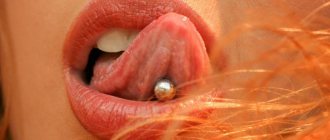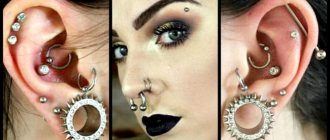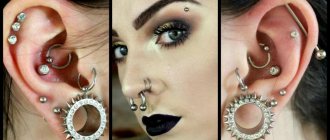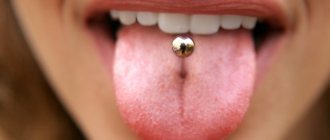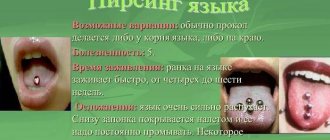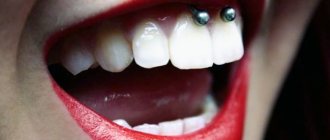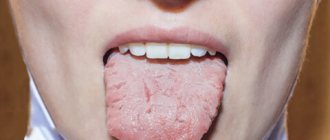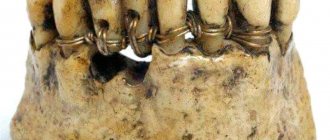Of course, jewelry earrings can vary greatly both in cost and aesthetic appeal, as well as in ease of wearing. And meet the basic requirements for jewelry:
- Must have a smooth, easy-to-work surface.
- The carvings on the jewelry should be completely hidden under the ball.
- Decorations should not squeeze the fabric.
So, let's look at the main options.
Banana
It resembles a slightly elongated barbell, but somewhat rounded. Its shape is a bit like an exotic fruit, that’s why it’s called that. Wraps are selected according to size, carving and type of stone.
Barbell and barbell
A straight stick with holes at the ends onto which twists, balls, and pebbles can be screwed. The base is made of bioplastics, medical alloys or precious metals. They are used not only for ear piercing, but also in puncture sites on the body: the bridge of the nose, navel, tongue, nipples, and sometimes intimate areas. Standard product sizes vary from 1.6 mm to 50 mm, depending on the destination.
Labrets
Labret
It is a rod with a cap and a loose ball. It can be called a fairly universal decoration: it can be inserted into piercings of the ears, lips, cheeks and even chin. The most common jewelry is in the form of a barbell, at one end of which there is a flat disk, and at the other end a ball or wrap with a stone. Along with ordinary barbells, they are used for piercing the lobe or cartilage of the ear, cheeks and lips. Standard model sizes vary from 1 mm to 1.6 mm. Thicker products are considered uncomfortable as there is an increased risk of injury to the punctured area.
Circular
A circular or half-ring is one of the types of earrings for piercing, similar to barbells, twisted almost in a circle. Stylish decoration for septum, earlobes, Daith piercing and other options. Most often they decorate the ears, eyebrows, lips, nose, navel and nipples. The sizes are selected depending on the type of wrap, but most often they have standard values from 1.2 mm to 16 mm.
Clamp ring
This type of jewelry is distinguished by the type of clamp that contains two grooves in which the ring snaps into place. The decoration can be supplemented with a removable element. It can be either a ball or a crystal. The clamp ring is popular for septum, lobe and Daith piercings. Most often used for piercing the ears, lips, nose and eyebrows.
Cheats
A rod of various sizes is used as the basis for wrapping. The wrap itself acts as a decoration, and can have several options. The most common of them are precious stones, but they can also be ordinary balls, hearts and other shapes. According to the shape, the “tip” of the rod is also divided into bezel, cabochon, prong, cluster and flat-gem. Essentially, this is a rolled stone, a flat uncut stone, a crystal in a frame, several crystals in a composition and rhinestones with a flat bottom, respectively. The products are removable, which allows you to change earrings as desired.
In addition to the main types of jewelry, there are also many variations, differing in details. In particular, the most famous include a segment ring, similar to a clamping version, a twister, reminiscent of a circular, a retainer - an improved version for a septum, a clicker, a sufreys bar, and other types of jewelry. You can find the ideal solution by contacting a specialist who you are willing to trust to perform the puncture. Along with care instructions, the master will tell you about the properties and characteristics of different types of earrings.
Types of tongue piercing
There are four types of tongue piercing:
► Vertical - from the frenulum to the palate. Classic and most common puncture.
► Horizontal - the puncture is located on the tip of the tongue, from ear to ear (wide)
► Superficial - the puncture is made across the tongue
► Tongue frenulum piercing – piercing under the tongue
Brief historical background
The earliest evidence of tongue piercing comes from the rituals of the Mesoamerican peoples, who used plant spines as tools.
It is known that the procedure was performed to initiate a person into the upper echelons of society and was part of a cult. The indigenous people of Australia considered tongue piercing a means of exorcism and treatment against evil magical influences.
The fashion for this type of piercing came to Europe already devoid of religious significance. In the 1990s. The popularity of body modification began to flourish, and such piercing was demonstrated by many youth idols, music and film stars, making it a symbol of freedom of expression and sexuality. Since then, it has been included in the range of services of most piercers.
Choosing jewelry for piercing
Jewelry for tongue piercing must be made of high-quality material - titanium . Medical steel, gold, silver and other metals contain foreign alloys, which, when in the human body, begin to oxidize, and in the oral cavity this process is much faster, so the consequences after tongue piercing with such jewelry will be very unpleasant. For primary healing, 1.6x22 rods are used (sometimes longer, based on individual measurements of the tongue); a shorter rod can be replaced 2-3 weeks after the puncture. For those who really want a tongue piercing, but have not yet decided, there is a tongue piercing - such jewelry is held on by suction cups or magnets.
Healing
From two weeks to a month. Rapid healing is due to the microflora of the oral cavity and good blood circulation.
Care
Remember that the oral cavity, especially the tongue muscle, has strong blood circulation. In this regard, after the piercing procedure, the entire perimeter of the tongue tends to react with swelling, both moderate and severe. This is a temporary reaction. The swelling subsides on the 4-6th day after the procedure.
In addition to general care, a primary liquid diet is extremely important. Nominally, consumption of dairy products, baby food, liquid cereals, pureed soups (from the 3-4th day). You should refrain from any serious taste and thermal irritants such as spicy, bitter, very salty, sour, hot or very cold foods, in order to avoid irritation of the wound surface and slow down the recovery process. You can return to your normal diet from the 6-7th day after the procedure, doing this gradually.
For general care, the antiseptic Miramistin is optimal. Rinse should be done after every meal and after brushing your teeth. It will not be superfluous to rinse with purified water after eating food and brushing your teeth, so as not to leave food and toothpaste residues near the wound surface.
Rinsing should last no more than 3 weeks. Remember that even such a mild oral antiseptic as Miramistin can have a slight “rinsing” effect on your own microflora, depriving it of some regenerative and immune abilities. The environment is not sterile and must resist foreign microflora.
Puncture procedure
First of all, the master helps you choose jewelry. For initial healing, a 1.6x22 bar is placed in a classic tongue piercing; this is a standard size, which, in case of swelling after the piercing, will prevent the jewelry from digging into the tongue. Wraps are selected for the bar depending on the client’s preferences. Next, the master gives the client to rinse his mouth with octenisept and makes markings, looking at the anatomy of the tongue. After this, sterilized instruments are taken out, the tongue is held with a special round clamp and a puncture is made with a piercing needle, with the help of a taper the jewelry is smoothly inserted and the screw is screwed on. After the piercing, your tongue will hurt and swell, but you shouldn’t be afraid of this; the pain will go away quickly if you follow all the recommendations that the master will give you.
Types of punctures and their approximate cost
As an example, here are the average prices for tongue piercing in Moscow:
- Vertical is a classic technique; in different salons its cost ranges from 1,200 to 4,000 rubles.
- Superficial - the tongue is not penetrated through. This complex puncture requires attentiveness and skill from the master. Prices for this type of service can range from 1,500 to 4,000 rubles.
- Horizontal - only the tip of the organ is perforated. Such a puncture costs 1200-4000 rubles.
- A composition of several punctures (along the tongue or along the axis) can cost 3,000-10,000 rubles.
- A frenulum piercing will cost 1200-2000 rubles.
The final price of a piercing consists of 3 components:
- The work of a master is an experienced specialist who has undergone specialized training.
- Decoration. If the average cost of a titanium earring is 300 rubles, then a similar product made of surgical steel will cost 600 rubles. Jewelry accessories containing precious metals and stones are the most expensive and can cost 8,000 rubles. and more.
- Additional options offered by the salon. Anesthesia costs an average of 300 rubles.
Tongue piercing care
In order for the piercing to heal well, you need to know how to care for your tongue piercing. Caring for a tongue piercing includes constant treatment of the oral cavity - Lakalut, Asepta or President rinses ; you need to rinse your mouth 4-5 times a day and after each meal and drink. Swelling after tongue piercing lasts at least 4-5 days, so during this time you will have to refrain from active conversations, hard, spicy and salty foods . If you notice that plaque has appeared after your tongue piercing, you should not try to remove it, as you will injure the piercing. After 2-3 weeks, you can change the barbell to a shorter one (downsize).
Problems and inflammation
The main problems with tongue piercing healing are improper care, lack of oral hygiene, or the consequences of a healing process aggravated by colds.
The consumption of alcohol and other vasodilators leads not only to an increase in blood pressure, but also to a decrease in basic immune functions. Their oppression will have an extremely negative impact on healing and all the ensuing processes. It is worth knowing that lactose (dairy products) with reduced immunity and a general inflammatory process during the healing of the piercing can cause candidiasis.
Be careful with general hypothermia and being in ventilated rooms. Any colds, viral, mild or acute infectious processes have an extremely negative impact on recovery.
Protect yourself from mechanical damage at least for the first 3 weeks. The cracks formed from them can become an easy and quick way for microorganisms unnecessary for healing to penetrate into the wound cavity.
REPLACEMENT OF CYSTOSTOMIC DRAINAGE (FOLEY CATHETER) AT HOME
Replacing the catheter should only occur if you have been trained by your attending physician and are allowed to carry out this manipulation yourself!
To replace your Foley catheter, you will need the following materials:
- a new sterile Foley catheter, which should be the same size as the old one,
- new sterile urine bag
- antiseptic solution (chlorhexidine, miramistin, furacillin, etc.)
- sterile gauze wipes, disposable alcohol wipes, bandage
- 1-2 pairs of sterile gloves,
- sterile syringe 20 ml,
- sterile liquid (saline, furatsilin, glucose) for inflating the catheter balloon.
Steps to replace a Foley catheter:
- Drain urine from the urine bag through a special valve.
- Wash your hands thoroughly and put on sterile gloves to the person who will be replacing the cystostomy.
- Take a syringe (without a needle) and connect it to the port for inflating the balloon (Figure 2)
- Pull the syringe plunger toward you until all the fluid from the Foley catheter cartridge enters the syringe. Then the syringe must be disconnected from the Foley catheter, the water from the syringe must be drained, and the syringe must be filled with a clean sterile solution (saline or glucose solution or saline)
- Carefully remove the old catheter from the cystostomy opening and place it in a plastic bag (the bag should be thrown away after replacing the cystostomy).
- Wash the skin of the cystostomy opening (fistula) with a prepared antiseptic or a disposable alcohol wipe, and then dry it with a sterile gauze wipe.
- IT IS VERY ADVISIBLE TO WEAR/CHANGE NEW STERILE GLOVES
- Carefully insert a new Foley catheter into the lumen of the bladder through the fistula (hole) in the suprapubic region. In this case, you should try not to sterilize the Foley catheter and hold it by the sterile sheath during replacement, gradually removing it from the sheath as the catheter passes through the fistula into the bladder
- After urine appears in the lumen of the catheter, the catheter should be inserted even deeper by 2-3 cm, connect the syringe to the port for inflating the balloon (Figure 2), inject 6-8 ml of sterile liquid into it, and then disconnect the syringe. DO NOT INFLATE THE CARRIER WITH AIR, SINCE THE CATHETER VALVE IS DESIGNED FOR LIQUID, NOT AIR!
- It is necessary to gently pull the Foley catheter towards you and make sure that the Foley catheter is securely fixed with the inflated balloon in the bladder and does not fall out (Figure 1)
- Re-treat the skin around the catheter with an antiseptic and dry with sterile gauze wipes.
- The bandage should be cut halfway down one side and applied to the skin around the new Foley catheter so that the catheter is in the center of the bandage. Make sure that the dressing does not pinch the Foley catheter.
Clamp
Used to fix skin folds. This allows you to make a more accurate and even channel and reduce pain.
Clamps vary in shape and size. The choice of clamp depends on the piercing area. To fix the fold of the eyebrow or nipple, a smaller tool is used; for the umbilical area, a larger tool is selected. The following types of clamps are distinguished by shape:
- Round. Especially indicated for areas of easy grip (lip, tongue);
- Triangular. Indicated for areas of more difficult grip (eyebrow);
- Clamp for septum (nasal septum). To avoid any distortions during piercing.
The first two types come with and without a slot. The slot helps you quickly remove the tool after the puncture is completed.
There is also a ring clamp that is used for:
- Compression of unclenched rings;
- Changing microdermal rings;
- Microdermal fixation.
Microdermal is a subcutaneous decoration.
Who shouldn't have their tongue pierced?
Any type of piercing is prohibited in case of low immunity, poor blood clotting, exacerbation of chronic diseases and acute mental disorders, diabetes, high body temperature and pregnancy (as it can cause unnecessary stress). Tongue punctures are prohibited in the presence of ENT diseases, inflammatory processes and dental problems. In addition, it is necessary to take into account that an allergy to metals may occur. You should not use the services of an establishment where sanitary conditions are questionable or you do not trust the craftsmen.
Are there age restrictions
Any piercing and tattoo salon conducts procedures only for adults or in the presence of their parents. However, the tongue can only be pierced after 18 years of age, because The organ only finishes forming by this age. There is formally no upper age limit for the procedure, but some diseases typical of older people are contraindications.
Painfulness of the procedure
Tongue piercing is considered one of the most painless types of piercing. If the procedure is performed by an experienced master, then he inserts a needle with a catheter into those points where there are the fewest receptors and nerve endings. The piercing itself does not take even a minute. In most cases, the client feels almost nothing. If there is a low pain threshold or concerns, anesthesia is used.
How are piercing needles constructed?
A catheter for puncturing the nose is a fairly simple device that looks like a regular medical needle , equipped with a special handle holder and a plastic tube. The main part of the instrumentation is a very sharp and sterile needle with a cut edge, which is used to puncture the nasal tissue. A plastic cap is placed on top of this part of the catheter to prevent biological contamination of the piercing part of the device.
For more convenient and comfortable work for the piercer, one edge of the catheter is equipped with a plastic handle, on the surface of which the fingers of the upper limb are fixed. The cap covering the needle is removed immediately before the procedure of piercing the nose, or another part of the body. Until opening, the entire catheter is stored in sterile plastic packaging.
Why is a cystostomy needed?
A cystostomy is installed for a patient in urological practice for various diseases and conditions. The most common reason is the patient’s inability to urinate independently, which can occur in the following conditions: 1) benign prostatic hyperplasia (BPH, prostate adenoma), 2) injuries to the urethra (urethra), 3) injuries to the bladder, 4) recovery period after surgery on urethra, prostate gland, bladder, penis, 5) damage to the spinal cord in a patient (bedridden patients).
ONLINE TRAINING. Piercing
The training center conducts several seminars and presentations of represented brands per month on the most pressing topics.
Meeting with colleagues and the opportunity to gain practical experience and participate in discussions, ask your questions is always useful and improves your qualifications.
Webinars/recording of seminars for cosmetologists
The seminar program includes both a theoretical part and master classes on face and body care. Themes:
- Skin structure. Anatomical and physiological features of the structure of facial skin. Main skin types. Functional condition of the skin. Classification of skin types. Skin diagnostics.
- Stages of care for different skin types. Skin around the eyes with dark circles and swelling. Home eyelid skin care, selection of eyelid care products.
- Anti-aging skin care for the face, neck, and décolleté. Skin condition assessment. Hardware techniques.
- Peeling with AHA acids. Basic rules for skin care during the peeling course and after the peeling. We select the course and frequency of the procedure.
- Specific features of skin prone to the formation of spider veins. Prevention of rosacea, development of care programs.
